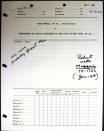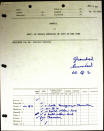|
The short answer is that each case file
contains digital copies of
every
document that can be found in the actual,
hard copy files of the justices of the
Supreme Court.
Petition to Decision includes
all the
documents so that you can decide which of
them are
important for your research. For
example, if more than one
justice had a copy of a particular document,
the website contains every copy because the justices
often made significant
handwritten notes on their individual copies.
The total number of documents varies from
case to case—Monell
contains approximately 1800 pages while
Owen has only 800—and each
individual file contains a wide
range of documents. Shown below
are examples of some important types of
documents you will ordinarily find in every
file: |
|
Types of Documents |
Click Images to See Examples |
|
Conference Notes:
Shortly after oral argument, the justices
meet to discuss and vote on each case.
No one is present at these conferences other
than the justices themselves, but the
justices do make personal notes which are
essentially the only record of what was
said. |

Justice
Powell’s
Conference Notes re Owen |
|
Internal Memos:
The justices and their clerks frequently
write memos discussing a case, recommending
how it should be decided, suggesting changes
in draft opinions, or agreeing to join in
another justice’s opinion. Click
the picture for an example. |

Law Clerk’s
Memo to Justice Marshall
re Monell
|

Justice
Brennan’s Memo to Conference re Monell
(with Justice Powell’s Comments) |
| Dockets
(Vote Records): Parties
who want the Court to hear their cases
ordinarily file a request for review called
a "petition for writ of certiorari" and the
opposing party may file a brief in
opposition. The
decision whether to hear the case is made at
meetings of the justices called "cert
conferences." The principal record of
what takes place at those conferences is a
handwritten form called a "docket."
Dockets contain a justice’s personal record
of the other justices’ votes on whether to
hear the case. They often also contain
additional notes about the discussion during
the certiorari conference and sometimes
record preliminary votes on the merits. |



1/7/1977
1/14/1977
1/24/1977
Justice Powell’s Dockets for the
Three Certiorari Conferences on Monell
|
| Pool
Memoranda:
Most of the justices have agreed to delegate
the initial review of petitions for
certiorari to law clerks through the "pool"
system. The petitions are divided
among all the justices’ law clerks and the
assigned clerk then writes a memorandum
analyzing the case and recommending whether
the review should be granted. This
"pool memorandum" is sent to each of the
justices and each justice’s clerk
individually annotates it with his or her
own thoughts and recommendations. The
justice will often make additional notes on
the pool memorandum. |
.jpg)
Pool Memo re
Tuttle
with Comments by
Justice Blackmun and
His Clerk |
|
Opinion Drafts:
The opinions almost always go through
multiple drafts and the justices frequently
make extensive handwritten notes and
comments on those drafts. The
drafts, notes and comments provide important
insight into the justices’ thinking.
|
.jpg)
Justice
Rehnquist’s
4th Draft Opinion re Tuttle
(with Justice Blackmun’s Comments) |






.jpg)
.jpg)